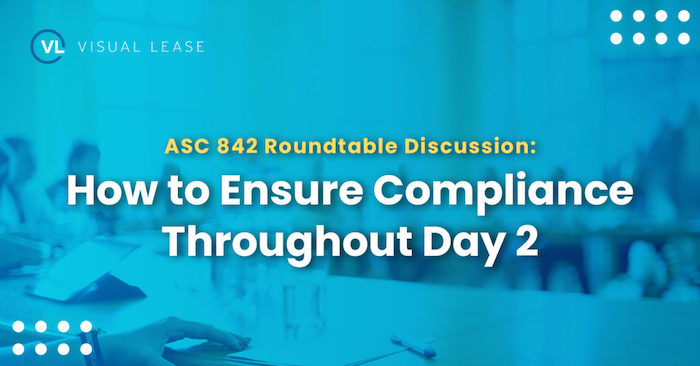Without a firm grip on your leases, you will likely have trouble sustaining accurate lease data. This puts your business at risk of misreporting company lease information to comply with ASC 842, which can lead to increased audit fees and fines, legal action and more.
In our recent webinar, ASC 842 Roundtable Discussion: How to Ensure Compliance Throughout Day 2, experts from Visual Lease and Embark discussed how to instill confidence in your lease data through:
- Data Management: Keeping up with lease modifications and terminations, as well as data abstraction and validation
- Change Management: Understanding new requirements and educating staff, as well as maintaining processes, policies and controls
- Audit Prep: Ensuring you’re ready for your year-end audit
To learn more, read the summary below or view the on-demand webinar.
The importance of data management
You can’t manage your leases (stay on top of critical dates and options) without entering your lease data into a digitized solution. Often known as lease abstraction, this process is considerably one of the most time-consuming, risky parts of preparing for lease management and accounting.
Entering your leases incorrectly could lead to some big mistakes within your financial reports. In this webinar presentation, Matt Watson, Director of Implementation at Visual Lease, shared how businesses can validate their data right from the start for reliable results.
In addition, once your lease data is accurately abstracted within a dependable solution, that is when true data management comes in. Leases are fluid contracts – they are always changing. Whether your organization modifies, terminates or takes on new leases, each of these changes will need to be accounted for.
This can be incredibly cumbersome without technology that makes your lease data easily accessible.
Understanding new requirements and educating staff
To stay audit-ready, your business must plan for how its going to maintain policies and lease controls – and keep staff up-to-date on any changes. This includes changes to the accounting standards and the leases.
Because leases reside within different departments (such as supply chain, IT, etc.), you’ll need to make sure there’s a way for the departments to communicate any updates to leases they’re responsible for. This onerous process requires more collaboration than just between finance, accounting and real estate.
What to do to be audit-ready
Lastly, the presentation shared insights on documentation that businesses should have ready for their auditors. Businesses should provide both a PDF and Excel version of the disclosure report that includes the accounting calculations. This provides auditors with a view into your process, so they can see how your reports were calculated.
Besides disclosure reports, you may also want to produce a journal entry summary report, adoption memo, other testing scenarios and SOC reports if you used a software solution to prepare your lease financials.
For more details about how to stay audit-ready, view the on-demand webinar: ASC 842 Roundtable Discussion: How to Ensure Compliance Throughout Day 2.




